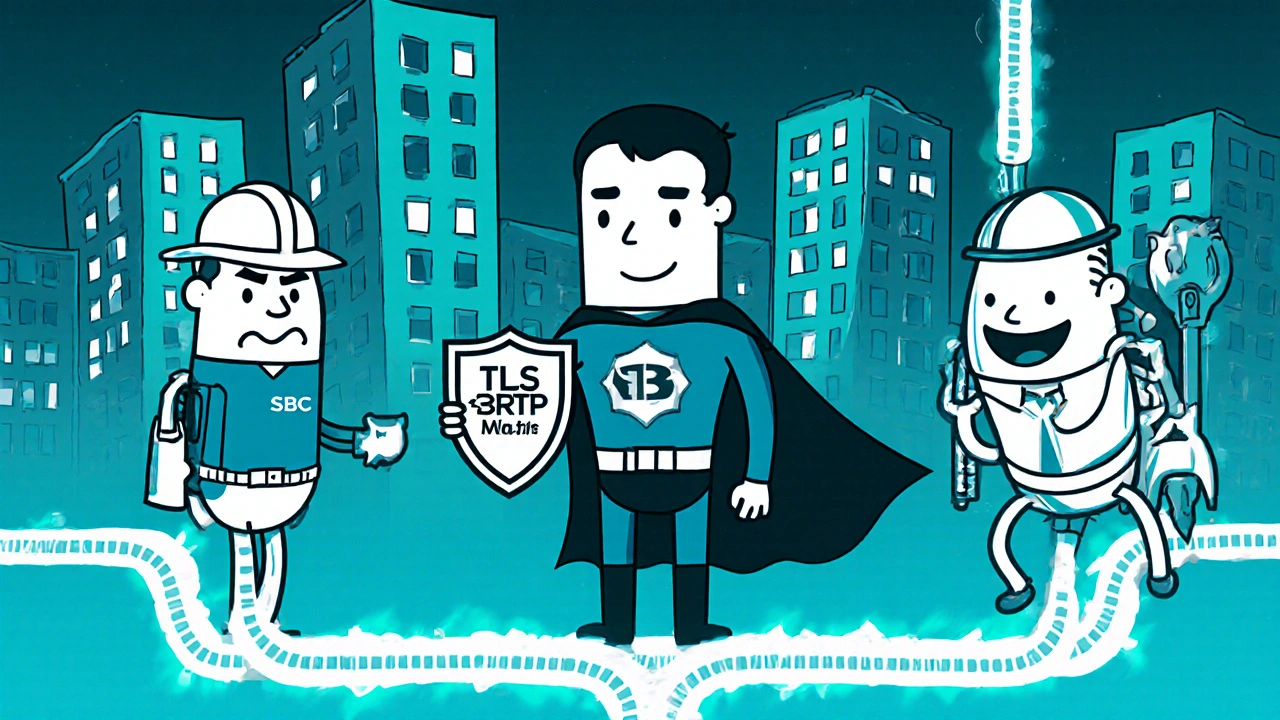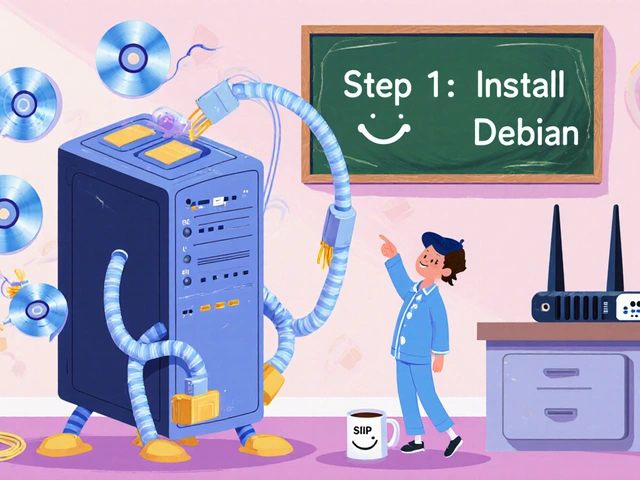When you make a call over the internet using a business phone system, it doesn’t just magically connect. Behind the scenes, your PBX needs to talk to your phone service provider using SIP trunking. But how that connection works isn’t the same everywhere. Two main methods dominate: SIP registration and static IP peering. Choosing the wrong one can mean dropped calls, security gaps, or hours wasted on configuration. And if you’re managing multiple offices or moving to the cloud, this decision shapes your whole telecom future.
What SIP Trunking Actually Does
SIP trunking replaces old phone lines with a single internet connection that carries all your voice, video, and even fax traffic. Instead of running copper wires from your office to the phone company, you connect your PBX - whether it’s an on-premise Avaya, a cloud-based 3CX, or an Asterisk server - directly to your VoIP provider. This cuts costs, adds flexibility, and lets you scale up or down without hiring a technician to install new lines.
But here’s the catch: SIP trunking isn’t one-size-fits-all. The way your PBX authenticates and connects to the provider determines reliability, security, and how easy it is to manage. That’s where registration and static IP peering come in. They’re not just settings - they’re fundamentally different architectures with trade-offs you can’t ignore.
Static IP Peering: Direct, Fast, and Locked Down
Static IP peering is like building a private tunnel between two fixed points. Your PBX and your VoIP provider each have a static public IP address. When a call starts, the system checks: Is this call coming from the IP address we’re expecting? If yes, it goes through. No usernames, no passwords, no server in the middle.
This setup is common in government agencies, banks, and manufacturing plants where every device has a fixed IP. It’s fast - calls route directly without extra hops. Tests show it uses 15-20% less bandwidth than registration because there’s no registration ping or keep-alive traffic eating up your pipe.
Configuration looks like this in Asterisk or FreePBX:
host=x.x.x.x- the provider’s static IPtype=peer- tells the system this is a direct connectioninsecure=very- disables some checks (risky, but often needed for compatibility)qualify=yes- constantly checks if the connection is alivecanreinvite=no- prevents call rerouting that can break NAT
But this simplicity comes with serious limits. If your office moves or your ISP changes your IP (even once), the trunk breaks. No calls go through until you update the provider’s config - which can take hours if you’re not on their VIP list. Multi-site deployments become a nightmare. Each branch needs its own static IP, and each one must be manually added to the provider’s allow list.
Security? It’s strong - if configured right. No credentials to steal. But if your firewall rules are sloppy, attackers can spoof your IP and start making free international calls. According to SANS Institute, 22% of VoIP breaches in 2022 came from misconfigured peer trunks.
SIP Registration: Centralized, Scalable, and Slightly Slower
Registration is the opposite. Instead of trusting an IP, your PBX logs in using a username and password - like logging into your email. Every few minutes, your system sends a registration request to the provider’s SIP server. The server says, “Yeah, you’re allowed,” and keeps you on the list. Calls are routed through that server.
This is what most cloud VoIP providers use: Twilio, Telnyx, Bandwidth.com. Why? Because it’s easy to scale. Add a new office? Just install the PBX, enter the credentials, and you’re done. No need to coordinate IPs with your provider. You can move offices, use dynamic IPs, even run your PBX from a laptop in a coffee shop - as long as you have internet.
Configuration is simpler too:
host=dynamic- accepts any IPtype=user- authenticates by credentialsusername=youraccountsecret=yourpasswordregister=youraccount:[email protected]
But there’s a cost. Every call goes through the provider’s registrar, adding 10-15ms of latency. Not much, but it adds up in call centers or real-time trading floors. And if that registrar server goes down - even for 30 seconds - all your calls drop. You’re now dependent on someone else’s uptime.
And credentials? They’re the weak link. Weak passwords, reused logins, or unencrypted registration traffic are the #1 cause of toll fraud. SANS found 68% of VoIP breaches in 2022 were due to stolen SIP credentials. That’s why TLS and SRTP encryption are non-negotiable here.

Which One Should You Choose?
There’s no universal answer. The right choice depends on your environment, size, and risk tolerance.
Choose static IP peering if:
- You have a single location with a fixed, static public IP
- You’re in a regulated industry (finance, healthcare, government)
- You need maximum control over your network path
- You’re on PCI DSS 4.0 compliance - network segmentation favors direct peering
- You can afford to lock down your network and accept manual updates
Choose SIP registration if:
- You have 3+ offices or remote workers
- Your ISP gives you dynamic IPs (most home/business ISPs do)
- You want to add new lines or locations in minutes, not days
- You’re using cloud PBX platforms like Microsoft Teams Direct Routing or Zoom Phone
- You prioritize ease of management over absolute control
Here’s a quick comparison:
| Feature | Static IP Peering | SIP Registration |
|---|---|---|
| Authentication Method | IP address | Username + password |
| Requires Static IP? | Yes - both ends | No |
| Call Routing Path | Direct PBX-to-provider | Through provider’s registrar server |
| Bandwidth Efficiency | 15-20% better | Higher overhead due to registration |
| Deployment Time | 4-8 hours (per site) | 1-2 hours (per site) |
| Scalability | Poor - manual IP updates | Excellent - add users via credentials |
| Single Point of Failure | Network connection | Registrar server |
| Best For | Secure, single-site, compliance-heavy environments | Distributed teams, cloud PBX, rapid scaling |
Hybrid Approaches Are the New Normal
Here’s what most enterprises are doing in 2025: using session border controllers (SBCs). An SBC sits between your PBX and the internet. It handles authentication, encryption, and NAT traversal. Your PBX talks to the SBC using static IP peering - secure and direct. The SBC talks to your provider using SIP registration - scalable and flexible.
This gives you the best of both: the security of direct connections and the manageability of cloud services. Leading providers like Twilio now offer “hybrid authentication,” letting you whitelist IPs AND require credentials - a smart middle ground.
And it’s not just about tech. The market is shifting. In 2023, 58% of new enterprise SIP trunks used registration. But 32% still chose peer - mostly for compliance. The rest? Hybrid setups with SBCs, growing at 35% year-over-year.

Common Mistakes and How to Avoid Them
Even experienced admins mess this up. Here are the top three errors:
- Using “friend” instead of “peer” in Asterisk - The “friend” type mixes user and peer logic. It’s easier to configure, but it opens security holes. Use “peer” for trunking. Use “user” only for endpoints like phones.
- Leaving “insecure=very” on - It bypasses authentication checks for compatibility. Sounds convenient. But it’s like leaving your front door unlocked. Always use TLS and SRTP, and only use “insecure=very” as a last resort during testing.
- Ignoring registration timers - If your PBX registers every 60 seconds but your provider expects 30, calls drop intermittently. Match the timer. Most providers use 120 seconds. Check their docs.
Also, don’t assume your provider’s support team will fix your config. They’ll tell you it’s “your PBX.” You need to understand the architecture yourself. That’s why knowing the difference between peer and user types isn’t optional - it’s survival.
What’s Next for SIP Trunking?
The IETF is working on Automatic Peering for SIP Trunks (draft-ietf-asap-sip-auto-peer-29). This could let two PBX systems discover and trust each other automatically - no manual IP entry. Imagine setting up a new branch and having the trunk auto-configure itself. That’s coming.
But until then, the choice is clear: If you need control and security, go static IP. If you need speed and scale, go registration. And if you’re serious about reliability, add an SBC. The future isn’t one or the other - it’s knowing when to use each, and how to tie them together.









michael T
30 Oct 2025 at 06:02Yo, static IP peering? That’s like locking your car but leaving the keys in the ignition and calling it ‘security.’ I’ve seen a client get ransomed because their ‘secure’ trunk got spoofed after their ISP changed their IP during a storm. Meanwhile, the registration guy? His whole company moved offices and didn’t miss a beat. The provider didn’t even notice. You think you’re in control? Nah. You’re just praying your firewall doesn’t glitch. And don’t get me started on ‘insecure=very’ - that’s not a setting, that’s a cry for help.
Also, who still uses Asterisk without TLS? Are you trying to give hackers a holiday gift? I’ve seen SIP credentials sold on dark web forums for less than a Starbucks gift card. Your ‘secure’ network is just a meme at this point.